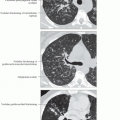Cross-Sectional Physiology
Jud W. Gurney, MD, FACR
Terminology
Definitions
Geometry of airways and arteries is important determinant of flow distribution
Airway branching
Asymmetric dichotomous pattern (each parent divides into 2 daughter branches of unequal size)
Asymmetric branching follows consistent rules (has fractal geometry)
Diameter and length of daughter branches reduced by consistent factor
Approximately 17 orders (counting from peripheral to central)
Pathology lengths to alveolar unit varies from 7.7-22.4 cm
Alveoli present after 14th branch point (from 14-23 generations)
Vascular branching
Asymmetric pattern similar to airways, exception
Supernumerary branches distally that arise at 90° from parent vessel and supply alveoli
Perfusion: Nongravity
Normal 4x increase in flow from central to periphery of lung in isogravitational plane
In asymmetric branches, total flow divided unequally and when continued over several generations, results in wide dispersion of perfusion
75% of blood flow may be attributable to vascular branching geometry in comparison to gravity
Transit time in pulmonary circulation longer in peripheral lung
Ventilation: Nongravity
Parallels perfusion, optimizes matching of ventilation and perfusion
Lymphatic function: Nongravity
Passive augmentation increased in lung periphery due to respiratory excursion
Experimental studies of particulate clearance show increased clearance from lung periphery as compared to more central lung
Secondary pulmonary lobule: Similar nongravitational gradient from core bronchovascular structures to periphery of lobule
Whether looking at lobes or lobules, regional differences in perfusion persists
This self-similarity independent of scale of measurement is feature of fractal geometry
e.g., paraseptal emphysema typically results in lung destruction along periphery of lung (lobes)
At level of secondary pulmonary lobule, same lung destruction is present primarily at periphery of lobule
Stay updated, free articles. Join our Telegram channel

Full access? Get Clinical Tree



